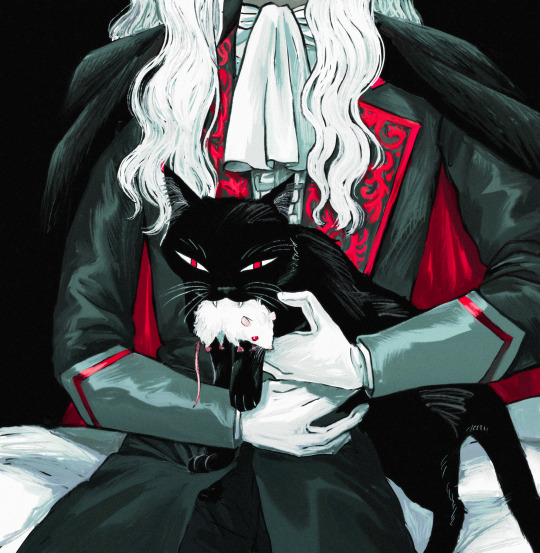#vellioth
Explore tagged Tumblr posts
Text
Vellicaz: I gave you eternity. Why are you crying?

#artists on tumblr#Vellicaz#cazador szarr#vellioth#Cazador#bg3 headcanons#bg3 hcs#bg3#bg3 Vellioth#bg3 cazador#baldur’s gate 3#baldur’s gate iii#baldurs gate 3#baldurs gate art#baldur's gate 3#bg3 art#dark art#vampire aesthetic#vampcore
67 notes
·
View notes
Text

He makes a fool of Death with his beauty 💔
#Astarion in a dress has arrived#had to compress the pic terribly sorry#astarion#astarion ancunin#bg3#fanart#artists on tumblr#art#baldur's gate 3#cazador szarr#bg3 cazador#tw blood#vampire#spawn astarion#vellioth#donella szarr#they are there behind the curtains I promise#clip studio paint#digital art#dnd#dnd art
8K notes
·
View notes
Text
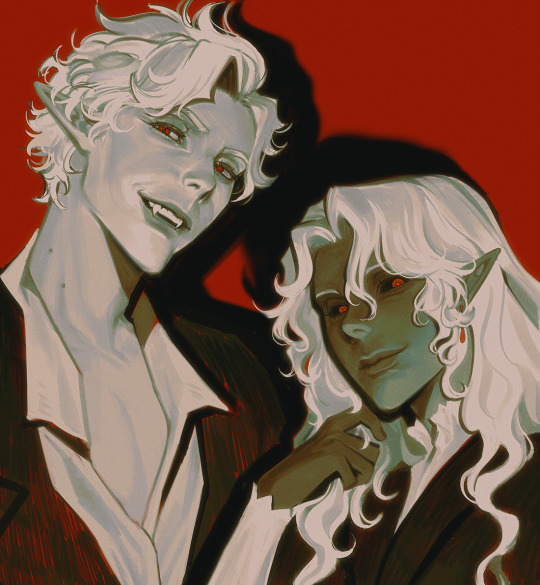
gossip girls
837 notes
·
View notes
Text
Rhapsody
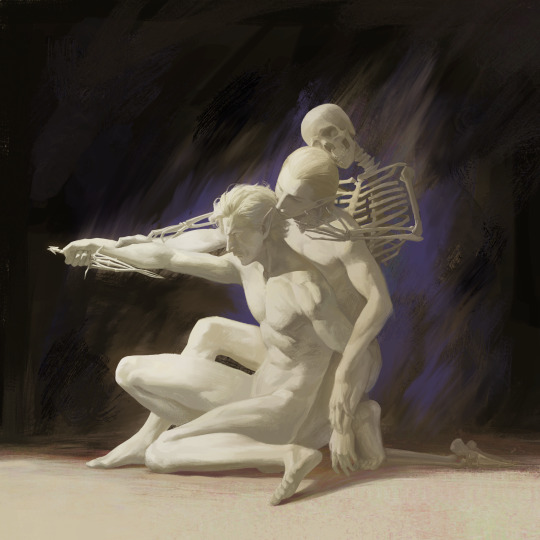
5K notes
·
View notes
Text
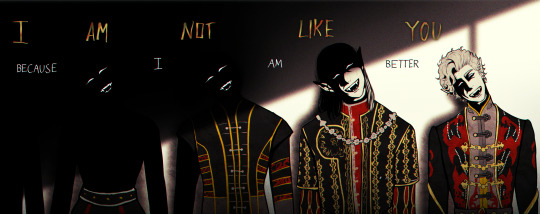
Gold, Blood and Darkness
#fanart#doodle#bg3#illustration#digital art#baldurs gate 3#baldur's gate 3#astarion#ascended astarion#cazador#szarr family#vellioth
3K notes
·
View notes
Text

Family portrait 🦇
3K notes
·
View notes
Text
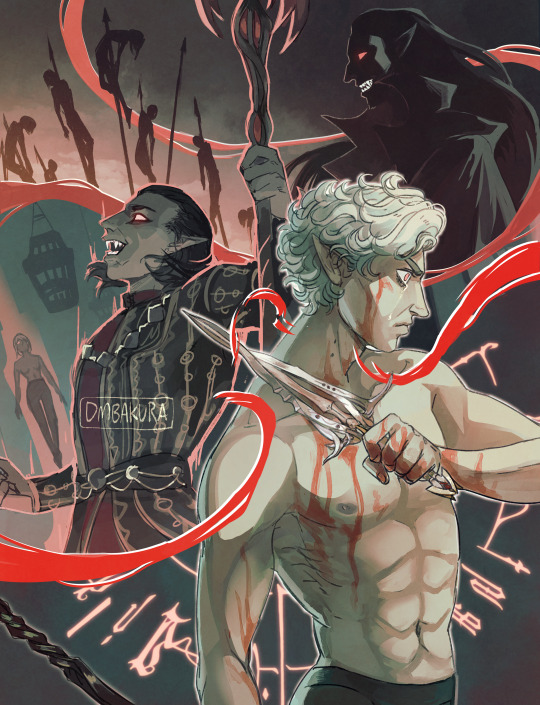
these aint my sins, i broke my chains
6K notes
·
View notes
Text

"Madness, no matter how he concealed, slowly erodes his once flawless beauty. "
– C. S
582 notes
·
View notes
Text

Well. @/barbatusart commissioned this.
#art#bg3#baldurs gate 3#baldur's gate 3#Cazador szarr#astarion#vellioth#vellioth the martinet#de rerum natura#dracula flow#commission
2K notes
·
View notes
Note
Who was Cazador?
What I mean is, who was he, before he killed Vellioth & took his place?
What was his personality like as a Spawn & as a mortal?
I can't help but think he used to be very different from the sadistic monster Astarion speaks of, the monster we meet in the crypt
And, is it wrong to feel for who Cazador used to be?
Whoever that was?
Even if we despise the person he goes on to become?
Wow, what a beautiful question. Truly deep and difficult. And precisely because of that, it's worth taking the time to reflect on it carefully.
Let’s start with the assumption that Cazador is a villain — yes, absolutely. But at the same time, he’s a fascinating and beautifully crafted character. In fact, I mourn the content that wasn’t fully developed by Larian when it comes to the characterization of this vampire lord who, in my humble opinion, had so much more to say.
Do I hate him? Yes. Did he harm Astarion and all the others? Absolutely. Does he deserve forgiveness? No.
But… BUT! There’s always a but.
He can still be analyzed, and we can even understand him — maybe even feel sadness for him, especially when we think about the path that led him to become the Cazador we all know.
A path that, in some ways, mirrors that of his own beloved and hated spawn, Astarion. But let’s take it step by step.
We have very little information about Cazador, especially regarding his past. Some details are merely hints—suggestions that wet the lips but do not quench the thirst, leaving space for imagination. In fact, they only sharpen the hunger for more. So, let’s start with what we do know.
Cazador is the vampire lord of Baldur's Gate, and his palace is located in the Tumbledown district. He was once a vampire spawn under Vellioth the Martinet, whom he succeeded through the Rite of the Perfect Slaughter. In turn, he sired seven vampire spawn of his own, including Astarion. Just as he once did under Vellioth, these spawn must follow strict rules with no possibility of disobedience.
He entered into a demonic pact with Mephistopheles — the Profane Ascension Ritual — which, once completed, would grant him the benefits of a mortal life and an increase in his vampiric powers, at the cost of a considerable number of souls.
Now let’s take a closer look at the clues we have. Cazador appears to be originally from Baldur’s Gate, and the Szarr family was seemingly once a powerful dynasty of merchants and landowners in the city — at least according to official Dungeons & Dragons lore, particularly from the sourcebooks Murder in Baldur’s Gate and Baldur’s Gate: Descent into Avernus. However, in those texts, the family was said to have been wiped out by a rival house, leaving Cazador as the sole survivor — a detail that contradicts what we learn in-game.
In Baldur’s Gate 3, the Szarr family appears to still have multiple members, including the named Amanita Szarr, Cazador’s niece, and Vellioth’s predecessor, Donnela Szarr. There are likely several other members whose true nature — whether mortal or vampiric — is unknown to us, such as Amanita’s parents. However, it is assumed that both of them are mortal, since they gave birth to a child. For this reason, I’m inclined to believe that the Szarr family is actually composed of mortals, and that only a select few are transformed into vampires. In this case, not vampire spawn, but true vampires—just like Amanita.
612-698 - Eravask the Forebear 698-713 - Zholtan Farr the Eviscerator 713-888 - Madame Tallon the Well-Preserved 888-955 - The Interregnum (temporary suppression by Lathanderians) 955-998 - Blaiseuse the Coryphee, who led her spawn in ecstatic blood dances 998-1019 - Dyckson Nightbinder 1019-1019 - Faibleur the Fleeting 1019-1138 - Hideous Gathwycke 'Who Knew Not Satiety' 1138-1204 - Donnela Szarr the Architect, who opened the Tourmaline Depths 1204-1276 - Vellioth the Martinet 1276-present - Cazador Szarr 'The Avid'
From this list compiled by Lady Incognita (aka Amanita Szarr), we can deduce that the vampire lords have succeeded one another with an average reign of 80–85 years, with Cazador at the top, having ruled for 216 years. Likewise, we can observe that not all the vampire lords who inhabited the Crimson Palace of Baldur’s Gate were members of the Szarr family, which suggests that power may have been usurped from time to time by outsiders. We are not given Vellioth’s surname—Cazador’s sire—so it remains uncertain whether he was a direct descendant of the Szarr line or a spawn who overthrew Donnela. We may never know.
We know that Cazador used the Kozakuran language to magically seal the ballroom door in his mansion during the Rite of Profane Ascension (and that he possesses a dictionary to decipher it). The Kozakuran language is associated with the region of Kozakura, which is inspired by feudal Japan within the world of the Forgotten Realms. Cazador’s use of this language appears to be a deliberate choice to add an additional layer of secrecy and protection to his domain.
Interestingly, Cazador’s facial features could also, depending on interpretation, evoke certain “Eastern” traits: high cheekbones, narrow and slightly elongated eyes, a sharp and symmetrical facial structure. This might suggest a subtle, almost invisible thread connecting the Szarr family to the region of Kozakura.
According to the description of the weapon Rhapsody, we know that Cazador’s attraction to poetry was born after he read a verse carved into the body of a dead child from his homeland. The child was hanging from the lowest branch of a tree, naked, with the poem etched into his stomach. Cazador read the poem, looked at the child, and realized that was the kind of art meant for him.
However, this doesn’t necessarily mean that his passion for art hadn’t existed prior to that moment — rather, it suggests that his perspective, already twisted by vampirism, found a form of artistic expression that better suited his nature.
It’s hard to believe that a centuries-old being would suddenly discover poetry just like that, as if he’d had no prior exposure to it. It seems more plausible that the scene struck a dark chord within something already in him — and that this gruesome encounter became a turning point, a moment of new artistic "awakening" shaped by horror and beauty all togheter. In his own prospective, of course.
We know that it was Vellioth who taught Cazador the rules of vampiric existence — and in my opinion, this is one of the most interesting aspects to consider when analyzing his character. It’s precisely here that some of the traits that once defined Cazador as a vampire spawn begin to surface.
First lesson: “Is to always dominate. Allow none to be your equal.”
“Vellioth recalls when Cazador reached out to a former friend. His punishment was to watch as Vellioth drained his friend dry.”
Second lesson: “Power comes from solitude. To share with others is to be weak, and to be weak is to fail… and die.”
"Vellioth recalls when Cazador rebelled against him. Cazador suffered eleven years of impalement… because he failed."
Third lesson: “Act not in haste. A near immortal has time to plan, time to act when others will pay the price of action.”
“Vellioth recalls Cazador, his lesson learned, killing him in the Rite of Perfect Slaughter. How they both laughed! Vellioth recalls Cazador boiling the flesh from his skull and then, to mock him, clamping his Schooling Scroll in Vellioth's jaws.”
These rules weren’t merely practical guidelines — they were mechanisms of control, identity, and survival, rooted first and foremost in paranoia, and second in narcissism. And the way Cazador internalized them, only to later impose them on his own spawn, reveals a disturbing cycle of abuse and domination.
But understanding that Cazador was himself once shaped by these very constraints allows us to see him not only as a villain, but as someone who, before becoming the tyrant we meet in the game, was himself a product of someone else’s system. And while this doesn’t excuse his actions, it certainly deepens the tragedy of what he ultimately chose to become.
But there are a couple of things that have always struck me whenever I interacted with Vellioth’s skull. The first is the way the narrator describes the interaction. The skull invites the player to witness its memories—and it does so with urgency. What it has to say—or rather, to show—is of vital importance.
The fact that one feels invited to observe its memories—and that the sensation is urgent—suggests that Vellioth wants to be seen, understood, remembered. Even in death, he still exerts a certain charisma, a certain authority. It’s as if his legacy itself demands attention, as if there’s something unfinished, a message to be delivered. Not just to Cazador, but to anyone who steps into his domain.
This urgent “invitation” can also be read as a call to bear witness to a cycle of violence and dominance that repeats itself—almost as if Vellioth wanted to leave a final mark, or perhaps even justify himself. The urgency might indicate that his story is essential to understanding what Cazador has become—and, by extension, what Astarion is on the verge of facing.
One could speak in terms of narrative foreshadowing, and it’s an incredibly powerful storytelling signal. It tells us that Vellioth’s story is key to understanding what it means to be a spawn, to be a vampire, to be part of a chain of power. It marks the beginning of a true confrontation with the past—not just for Cazador, but for whoever faces him… and for Astarion, who is the next generation.
The second thing that has always felt off to me is how Vellioth laughed together with Cazador at the moment of his own death. Every time I’ve thought: “What the hell are you laughing at, you idiot? He just killed you! What the fuck is so funny—are you stupid or what?!” But that thought, spontaneous as it may be, always leads me to deeper reflection.
Why does Vellioth laugh? Let’s try to hypothesize a few possibilities.
The Laugh of Approval Vellioth laughs because he wanted this to happen. In vampiric societies, the idea that a spawn kills their sire is part of the natural cycle of power—brutal, predatory, but also "meritocratic." In this sense, the laughter is a sign of satisfaction: Cazador has learned the lesson. He has shown strength, determination, ambition. Vellioth laughs like a master watching his pupil surpass him with pride.
The Laugh of Cruel Irony Alternatively, Vellioth laughs at the cruel irony of fate. Cazador spent years trying to escape the oppression of his sire—only to become exactly like him. The cycle repeats. The oppressor was once the victim. The laughter, in this reading, is a bitter realization: “You thought you were freeing yourself from me, but I will live on inside you forever.”
The Laugh of Relief Another possibility is that Vellioth had been waiting for this moment. Perhaps his long existence had become unbearable. Perhaps he could no longer evolve, no longer feel pleasure, no longer find purpose. In this sense, Cazador liberates him—and the laughter is an act of relief, almost cathartic: finally.
The Laugh of Madness Lastly, we could interpret it as an act of pure madness. Ancient vampires, corrupted and centuries-old, often develop extreme psychological traits. The laughter may be a symptom of delirium, of a mind shattered by time and power. A senseless laugh, not governed by logic, but embodying the chaos of the moment and the collapse of an identity disintegrating under the final blow.
Of course, to truly understand Cazador (and Astarion as well), I believe it's essential to understand who came before him. They all share vampirism and everything that comes with it, and at the same time, they are entangled in the machinery of vampiric society—a ruthless, cruel hierarchy that has deeply transformed them.
So, if we consider what can be read in Cazador’s mind while he lies in his sarcophagus, we can reasonably assume that Vellioth’s laughter was both an act of liberation for himself and a mocking gesture toward Cazador. And his urgency to tell his story might very well take on the tone of a genuine warning—directed at Astarion, who is about to walk down the very same path.
“These deathless dreams hold memories of a mortal life once-forgotten. Of the boy I was, the man I became, the monster that will not end. I sleep, but cannot rest. I live, but cannot die. I’m eternal, and I grieve.”
At this point, I’d like to sum things up a bit, stepping into headcanon territory. Cazador belonged to the Szarr family and was born and raised in Baldur's Gate. I like to think that the family’s origins actually lie in the region of Kozakura, which would explain the eastern features he inherited and his choice to use that language to reinforce the security of his palace.As a direct descendant of Donnela Szarr—Vellioth’s mistress—he would have eventually been summoned by her to become a true vampire, just as happened to Amanita.
However, Vellioth, who did not belong to the family, seized power and overthrew his mistress. In this context, it’s easy for me to imagine that turning Cazador into his spawn was Vellioth’s way of delivering one final insult to his creator. A way to further crush the family that had damned him.
It’s not hard for me to believe that Vellioth was especially cruel to Cazador for this very reason—as if Cazador were paying the price for Donnela’s sins.
Up to that point, the Cazador I imagine is a man who loves art, poetry, sculpture. Perhaps a sort of patron who welcomes and funds those who demonstrate talent, completely unaware of what awaits him. A man with a personality entirely different from Astarion’s: more reserved, more introspective, slightly introverted. And yet someone with a vast inner world and emotional depth—someone capable of recognizing and appreciating the beauty inherent in everything: in music, in nature, in the brushstrokes of a painting, in the verses written on parchment. Before poetry and music became that faint undertone woven into Astarion’s screams of agony — as if the spawn were a finely tuned instrument made of flesh and bone.
And I believe Cazador was a man who deeply desired a family. Or, even worse, that he had one—and it was torn away from him the moment Vellioth claimed him for himself. We know for sure he had a friend who was drained of life by Vellioth personally. A warning, yes, but also a way to keep his spawn bound to him. It's common for abusers to burn everything around their victims so they become the sole point of reference. And it's telling how Cazador does the same with Astarion the very moment he discovers the existence of Tav/Durge.
In fact, if you go talk to Cazador without Astarion, the vampire lord states that once his spawn sees Tav/Durge never return, he’ll be forced to come back to him. Which also implies that emotional bonds and attachments are dangerous—an obstacle, if you will. That’s why one must be alone and superior to others. But I digress…
It’s always struck me as strange that Cazador wanted to “play family” with his spawn. Some might say it’s just one of his many sadistic games, aimed at stripping Astarion and the others of their dignity. And in part, that’s true—they are robbed of the autonomy and competence of adults. But on the other hand, Cazador genuinely seems to believe in this charade. Even if his vampirism distorts all his feelings, pushing him to pursue his goals without true empathy for those he sees as extensions of himself.
Still, I think this whole “happy family” idea is actually a twisted echo of the mortal Cazador, who either once longed for a family or mourns the one he lost. Astarion points this out, saying his master insisted they were a family even as he carved runes into their backs. And during the ritual, there are dialogues that refer directly to this dynamic. Cazador tells Astarion to straighten his spine, like an authoritarian father, claiming he has no respect for himself—not for Cazador, the master of the manor—but for himself. As if he truly cared about his “child’s” posture.
He also protests that Astarion should be begging the family for forgiveness—not him, the master—but the family, spawn included. These are the final moments; there would be no point in keeping up an act. Cazador genuinely believes it. And, after all, vampire spawn are the only "children" a vampire can ever have.
It's interesting, moreover, how even this was something Astarion internalized from his former master. In fact, although as a spawn he recognized how absurd and twisted it all was, as an ascendant vampire he goes on to refer to the vampire spawn he plans to create in the future as “his children.”
Naturally, the loving father Cazador either wished to be or may once have been is fully embodied, in his true vampire form, by the figure of the narcissistic parent. Let’s break down the traits:
Egocentrism and Need for Control The narcissistic parent sees the child as an extension of themselves, not as an autonomous individual. They want to control the child's choices, thoughts, emotions, and even identity.
Lack of Empathy They struggle or are outright unable to understand and validate the child’s feelings. The child’s emotions are often ignored, minimized, or mocked.
Constant Need for Admiration They expect the child to praise them, reassure them, and emotionally “feed” them. If the child succeeds, the parent takes credit; if the child fails, the parent blames them.
Destructive Criticism and Perfectionism They can be hypercritical and demand unattainable standards. Their criticisms are never constructive — they’re tools to belittle and maintain control.
Manipulative Behavior They use guilt, the silent treatment, victim-playing, or gaslighting. They shift the narrative to confuse the child and make them doubt their own perception.
Disregard for Boundaries They violate privacy, make decisions on the child’s behalf, and interfere in everything. They may also use emotional boundaries to foster dependency or guilt.
Flawless Public Image To outsiders, they may appear to be the perfect parent: charismatic, accomplished, involved. At home, however, they reveal a crueler, more demanding, or emotionally absent self.
Competition with the Child They may feel envious of the child’s success and attempt to outshine them. Sometimes, they even actively sabotage their relationships or achievements.
One could say these traits describe quite well Cazador’s behavior toward his vampire progeny — and especially toward Astarion. And here, I want to dwell further on the idea of Cazador as a former vampire spawn.
I’ve read theories suggesting that Cazador is so obsessed with Astarion because he might remind him of Vellioth. But personally, I think the opposite is true: Cazador sees in Astarion his former self — the person he once was — now fighting against the very incarnation of Vellioth, which is Cazador himself.
I believe that, for Cazador, this thought — however unconscious — is simply intolerable. Because not only has he become what he once despised, but Astarion acts as a mirror that reflects back at him everything he used to be, everything that once drove him despite what he has now become. And that hurts. It makes him ache. It makes him grieve for what he lost — something we already know from reading his mind, where he’s tormented by memories of the boy he once was.
And the only solution is to shatter that mirror. To erase the reflection. Just as Vellioth once shattered him.
If we go back to Vellioth’s “lessons,” we can clearly see how Cazador tries to eliminate Tav/Durge in the same way Vellioth eliminated Cazador’s friend. Or how Cazador locked Astarion in a tomb for a year — just as Vellioth impaled him for eleven. Both punishments came in response to the same offense: rebellion.
It’s a powerful parallel.
So yes, I do believe that Cazador — even though he had a different personality — faced his relationship with Vellioth in much the same way Astarion now faces his relationship with him. And in that, I think there’s also a thread of paranoia, because Cazador is perfectly aware of which of his spawn might one day try to overthrow him.
Perhaps it’s precisely the one who, like Cazador once did, may no longer carry a living flame — but still holds embers smoldering within, just waiting to reignite.
And there lies the root of his obsession: the constant monitoring, the watching, the controlling, the punishing, and so on.
So, to conclude and return to the beginning — to the fundamental question: Is it wrong to feel for who Cazador used to be? Whoever that was? Even if we despise the person he goes on to become?
No, it’s not wrong. On the contrary, it’s profoundly human.
Feeling something — sorrow, compassion, even a flicker of empathy — for who Cazador was or could have been doesn’t mean justifying what he became. It simply means recognizing that monsters aren’t always born; sometimes, they’re made. And sometimes, before the cruelty, before the power, before the hunger… there was simply a person, with all the complexities and shades that make someone human. The same ones we all share.
Astarion himself is living proof of that. He stands at the edge of the very same abyss Cazador once fell into. Feeling something for the man Cazador used to be is, in a way, a way of honoring the struggle of those who don’t become like him — who fight to remain themselves in spite of fear, pain, and hardship.
And beyond that — even a monster can suffer. Empathy isn’t weakness. It’s the refusal to look away — even when the story hurts.
So no — it’s not wrong. It’s necessary, if we truly want to understand the weight of what was lost.
I apologize if I completely went off on a tangent with all my thoughts and reflections — I may have written a bunch of nonsense, but I swear, the more I thought about the question, the more my brain kept making connections left and right. I hope I’ve managed to meet your expectations about who Cazador was before the monster… and that I wrote everything in language that was clear and (hopefully) correct! Thank you again for giving me something so meaningful to reflect on... <3
#astarion#astarion ancunin#cazador#cazador szarr#baldur's gate 3#bg3#bg3 astarion#bg3 cazador#headcanons#vellioth
144 notes
·
View notes
Text
Vellicaz : The first meeting. A nice heir to the family. A little bird in a golden cage. A dark future.

#artists on tumblr#vellicaz#vellioth#cazador szarr#vellioth the martinet#Cazador#bg3 vellioth#bg3 cazador#bg3 headcanons#bg3 art#bg3#bg3 fanart#bg3 fandom#bg3 artwork#baldur’s gate 3#baldur’s gate iii#baldurs gate 3#dark art#vampire aesthetic#vampcore
94 notes
·
View notes
Text

let's play revenge!
389 notes
·
View notes
Text
Family


5K notes
·
View notes
Text
Vampiric doll -bg3 comic Vellioth, Donnela Szarr

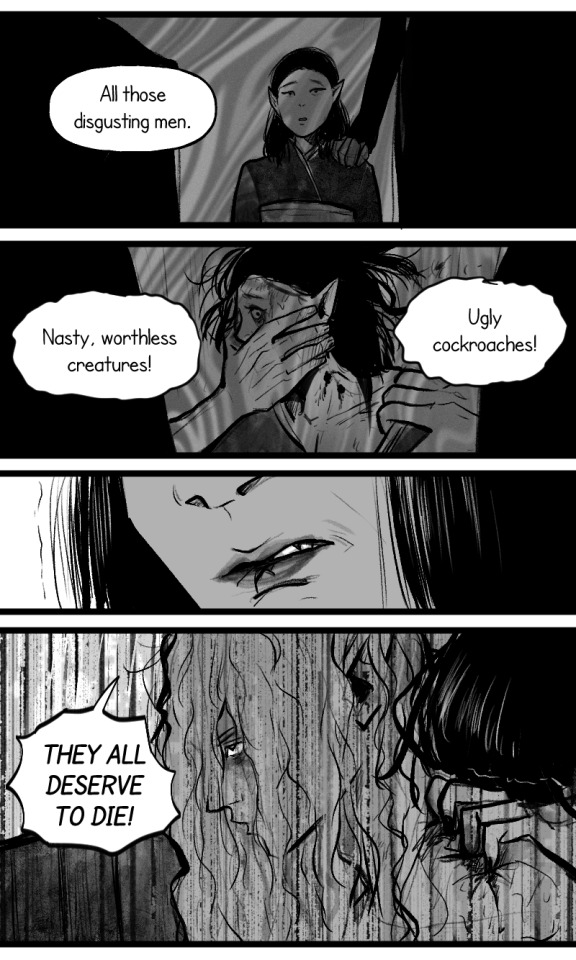


just a super quick headcanon idea.
1K notes
·
View notes
Text

Ooh I know Vellioth not resting peacefully

#digital art#art#baldur's gate 3#fanart#artists on tumblr#baldur's gate iii#baldurs gate fanart#bg3#bg3 fanart#baldurs gate 3 cazador#baldur gate 3#cazador szarr#bg3 cazador#vellioth#bg3 art#definitely hooting and hollering at that skull#baldur’s gate cazador Szarr#fuck his detailed outfit
121 notes
·
View notes
